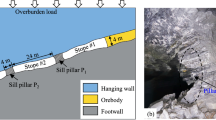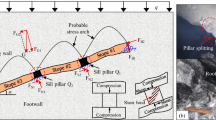Abstract
In order to improve the production capacity and efficiency of orebodies, the stope span enlargement with the overhand drift-and-fill mining method based on the pre-stressed expandable pillar support technology is developed by numerical simulation and on-site industrial test. The results demonstrate that compared with the natural pillar support, the vertical deformation of stope roof increases approximately 10 mm, and the stress release and plastic failure of stope roof slightly increase under the pre-stressed expandable pillar support. However, relative to no support, the expandable pillar support can effectively limit the vertical deformation (about 13 mm), stress release and plastic failure of stope roof. The farther the monitoring point is from the stope center or support position, the smaller the vertical deformation and stress release of stope roof will be. In general, the expandable pillar support technology can realize the “yielding support” to stope roof. With the stope span enlarging, the load on the bar-shaped natural pillar is immediately transferred to the adjacent expandable pillars, and the closer the distance is between the expandable pillar and the mining area or the stope center, the greater the bearing stress increment on the expandable pillar will be. The maximum bearing load on pre-stressed expandable pillars does not exceed 700 kN. Deriving from the industrial test, the support design of pre-stressed expandable pillars by the traditional pressure arch theory is conservative. The actual load on the support body is 1/6 times or less than the rock mass weight of stope roof within a semicircular area, and the load bearing area is equivalent to a parabolic shape with large opening. After the on-site industrial test is completed, the stope and expandable pillars are visually safe and stable. From the perspective of technical benefits, the stope span enlarges from 3 to 9 m, the ore production capacity increases from 30 t/day to 90 t/day, and the ore recovery rate improves by 30%. In terms of economic benefits, the profit of test stope is 77026 US$.















Similar content being viewed by others
Abbreviations
- R p :
-
Radius of plastic zone
- L :
-
Stope span
- h :
-
Height of stope
- γ :
-
Bulk density of surrounding rock mass
- H :
-
Buried depth of stope
- c :
-
Cohesion of rock mass
- φ :
-
Internal friction angle of rock mass
- Num:
-
The quantity of pre-stressed expandable pillars
- W p :
-
The width of pre-stressed expandable pillars
- [σ]:
-
Compressive strength of pre-stressed expandable pillars
- f :
-
Safety factor
- s :
-
Length of the test stope perpendicular to the strike direction
- S V :
-
The vertical stress
- K H :
-
The maximum horizontal stress
- K h :
-
The minimum horizontal stress
- P :
-
The active supporting force of a pre-stressed expandable pillar
- σ s :
-
The active stress of a single steel tube
- S :
-
Stressed area of pressure sensors
- E V :
-
The entire economic value
- ρ :
-
Ore density
- V :
-
The pillar volume
- ω :
-
The ore recovery rate
- δ :
-
The price of gold per gram
- α :
-
Average grade of ore
References
Abel JF (1988) Soft rock pillars. Int J Min Geol Eng 6:215–248
Barczak TM (2005) An overview of standing roof support practices and developments in the United States. In: Proceedings of the third South African rock engineering symposium, Johannesburg, Republic of South Africa: J S Afr I Min Metall, pp 301–334
Barczak TM (2006) A retrospective assessment of longwall roof support with a focus on challenging accepted roof support concepts and design premises. In: Proceedings of 25th International Conference on Ground Control in Mining, Morgantown, WV: West Virginia University, p 24
Barczak TM, Gearhart DF (1993) Engineering methods for the design and employment of wood cribs. US Department of the Interior, Bureau of Mines, USA
Barczak TM, Tadolini SC (2006) Standing support alternatives in western United States longwalls. Min Eng-Littleton 58(2):49–55
Barczak TM, Tadolini SC (2007) New support concepts for hard rock mining applications. In: Proceedings of the CIM Conference and Exhibition. Canadian Institute of Mining, Metallurgy and Petroleum, Montreal, Quebec, pp 30–37
Barczak TM, Tadolini SC (2008) Pumpable roof supports: an evolution in longwall roof support technology. Trans Soc Min Metall Explor 324:19–31
Barczak TM, Tadolini SC, McKelvey P (2004) Hydraulic pre-stressing units: an innovation in roof support technology. In: Proceedings of 23rd international conference on ground control in mining, Morgantown, WV: Coal International, pp 286–294
Barrientos G, Parker J (1975) Use of the pressure arch in mine design at white pine. Trans Soc Min Engrs 256(1):75–82
Batchler T (2017) Analysis of the design and performance characteristics of pumpable roof supports. Int J Min Sci Tec 27(1):91–99
Bieniawski ZT (1989) Engineering rock mass classifications. Wiley InterScience, New York
Brady BHG, Brown ET (1993) Rock mechanics: for underground mining. Springer science & business media, Geneva
Brown ET, Hoek E (1978) Trends in relationships between measured in situ stresses and depth. Int. J. Rock Mech. Min Sci 15:211–215
Clements M (2003) Shotcreting in Australian underground mines: a decade of rapid improvement. Shotcrete Spring, pp 6–9
Daehnke A (2001) Addressing the variability of elongate support performance. J S Afr I Min Metall 101(2):83–90
Daehnke MKC, Zyl V, Roberts M (2001) Review and application of stope support design criteria. J S Afr I Min Metall 101(3):135–164
Dinsdale JR (1934) Roof pressure arching and pressure cycles. Colliery Eng 11:5–8
Galvin JM (2016) Ground engineering-principles and practices for underground coal mining. Springer International Publishing Switzerland, Cham
Grobler H, Chatziefstratiou V, Mousli O, Yumlu, M (2019) Design of high-strength backfill for a drift-and-fill mining method at Olympias mine, Greece. In: Proceedings of the 22nd international conference on paste, Australia: thickened and filtered tailings, Australian centre for geomechanics, pp 401–410
Hamrin H (2001) Underground mining methods and applications. In: Hustrulid WA, Bullock RL (eds) Underground mining methods: engineering fundamentals and international case studies. Society for Mining, Metallurgy, and Exploration, Inc. (SME), Littleton, pp 3–14
Hoek E (1994) Strength of rock and rock masses. ISRM News J 2(2):4–16
Hoek E, Brown ET (1988) The Hoek–Brown failure criterion: a 1988 update. In: Proceedings of the 15th Canadian rock mechanics symposium, Toronto, Canada
Hoek E, Brown ET (1997) Practical estimates of rock mass strength. Int J Rock Mech Min Sci 34(8):1165–1186
Hoek E, Kaiser PK, Bawden WF (2000) Support of underground excavations in hard rock. CRC Press, London
Holland CT (1973) Mine pillar design. SME Mining Engineering Handbook. Soc, New York
Ji WD (1991) Mine rock mechanics. Metallurgical Industry Press, Beijing
Kenny P (1969) The caving of the waste on longwall faces. Int J Rock Mech Min Sci 6(5):541–555
Lang BDA (1994) Span design for entry-type excavations. PhD. Thesis, University of British Columbia, Canada
Li FQ (1995) In situ stress state in mainland China. Mech Probl Geodyn 145:775–787
Li KM (2019) Research on Load Bearing Mechanism and Application of Artificial Expandable Pillars in Hard Rock Stope. PhD. Thesis, Northeastern University, China
Li YH, Li KM, Feng XT, Cai M (2018) Development and evaluation of artificial expandable pillars for hard rock. Int J Rock Mech Min Sci 110(8):68–75
Luan HJ, Jiang YJ, Lin HL, Li GF (2018) Development of a new gob-side entry-retaining approach and its application. Sustainability 10(2):1–15
Mark C (2000) The state-of-the-art in coal pillar design. Trans Soc Min Eng 308:123–128
Mark C, Barczak TM (2000) Fundamentals of coal mine roof support. In: Proceedings of the new technology for coal mine roof support. National Institute for Occupational Safety and Health, Pittsburgh, PA, pp 23–42
Marlow P, Mikula PA (2013) Shotcrete ribs and cemented rock fill ground control methods for stoping in weak squeezing rock at Wattle Dam gold mine. In: Proceedings of the seventh international symposium on ground support in mining and underground construction. Australian Centre for Geomechanics, Perth, Western Australia, pp 133–147
Martin CD, Maybee WG (2000) The strength of hard rock pillars. Int J Rock Mech Min Sci 37(8):1239–1246
Maybee WG (2000) Pillar design in hard brittle rocks. MA Sc. Thesis, Laurentian University, Canada
Mucho TP, Barczak TM, Dolinar DR, Bower J, Bryja JJ (1999) Design methodology for standing secondary roof support in longwall tailgates. In: Proceedings of the 18th International Conference on Ground Control in Mining. West Virginia University, Morgantown, West Virginia, pp 136–148
Poulsen BA (2010) Coal pillar load calculation by pressure arch theory and near field extraction ratio. Int J Rock Mech Min Sci 47(7):1158–1165
Raby P (2001) Tilt prediction for total station. U.S. Patent and Trademark Office 6,243,658. 5.
Roberts DP, Van der Merwe JN, Canbulat I, Sellers EJ, Coetzer S (2002) Development of a method to estimate coal pillar loading. Safe Mines Res Advis Comm Rep 2001-0651
Yavuz H (2001) Yielding pillar concept and its design. In: 17th international mining congress and exhibition of Turkey, Turkey, pp 1–8
Zhao GY, Li Z, Li JY, Yu PP (2014) Reasonable pillar size design and nugget structural parameters optimization in room-and-pillar mining. J Central South Univ (sci Technol) 45(11):3943–3948
Acknowledgements
This work was supported by the State Key Research Development Program of China (Grant number 2018YFC0604601), and supported by the National Natural Science Foundation of China (Grant number 52004054), and Supported by Revitalization Talent Program (Grant number XLYC1805008).
Author information
Authors and Affiliations
Corresponding authors
Ethics declarations
Conflict of interest
The authors declare that there is no conflict of interest.
Additional information
Publisher's Note
Springer Nature remains neutral with regard to jurisdictional claims in published maps and institutional affiliations.
Rights and permissions
About this article
Cite this article
Li, K., Li, Y., Wang, Z. et al. Research on the Enlargement of Stope Span Based on the Pre-stressed Expandable Pillar Support Technology. Rock Mech Rock Eng 54, 4663–4675 (2021). https://doi.org/10.1007/s00603-021-02514-y
Received:
Accepted:
Published:
Issue Date:
DOI: https://doi.org/10.1007/s00603-021-02514-y




